| 参考文献No. | 58063 |
| 标题: | Substd. liposaccharides useful in the treatment and prevention of endotoxemia |
| 作者: | Kobayashi, S.; Kawata, T.; Christ, W.J.; Rossignol, D.P. (Eisai Co., Ltd.) |
| 来源: | US 5750664; WO 9639411 |
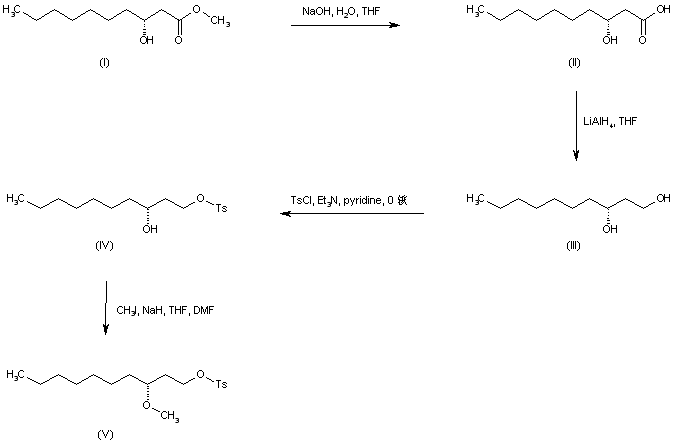 |
| 合成路线图解说明: Saponification of (R)-methyl 3-hydroxydecanoate (I) gave hydroxy acid (II), which was reduced to diol (III) using LiAlH4. Selective sulfonylation of the primary hydroxyl group of (III) provided tosylate (IV). The secondary hydroxyl group of (IV) was subsequently alkylated with iodomethane in the presence of NaH to furnish the methyl ether (V). |
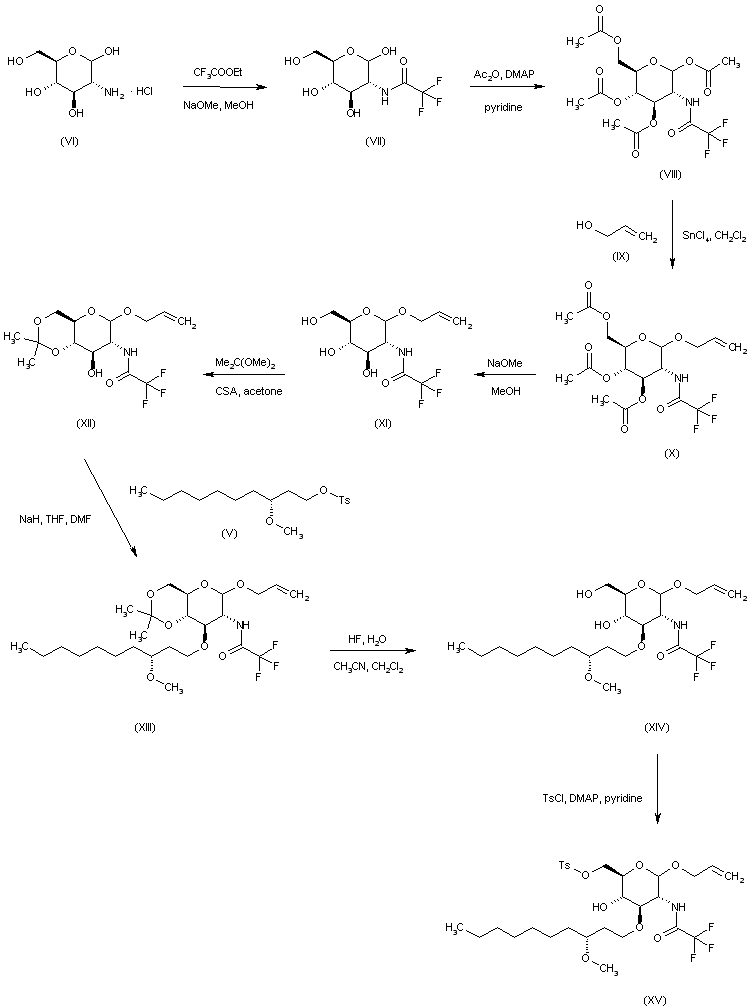 |
| 合成路线图解说明: Treatment of D-glucosamine旽Cl (VI) with ethyl trifluoroacetate and NaOMe produced the trifluoroacetamide (VII), which was subsequently acetylated with Ac2O yielding the tetraacetate (VIII). Displacement of the anomeric acetoxy group of (VIII) by allyl alcohol (IX) in the presence of SnCl4 furnished the allyl glucoside (X). After methanolysis of the acetate ester groups of (X), the resultant triol (XI) was protected as the acetonide (XII) by treatment with 2,2-dimethoxypropane and camphorsulfonic acid. Alkylation of the free hydroxyl group of (XII) with tosylate (V) under Williamson's ether synthesis conditions produced adduct (XIII). Selective hydrolysis of the acetonide moiety of (XIII) was accomplished by treatment with hydrofluoric acid to give diol (XIV). The primary hydroxyl of (XIV) was then converted to tosylate (XV) upon treatment with p-toluenesulfonyl chloride and DMAP. |
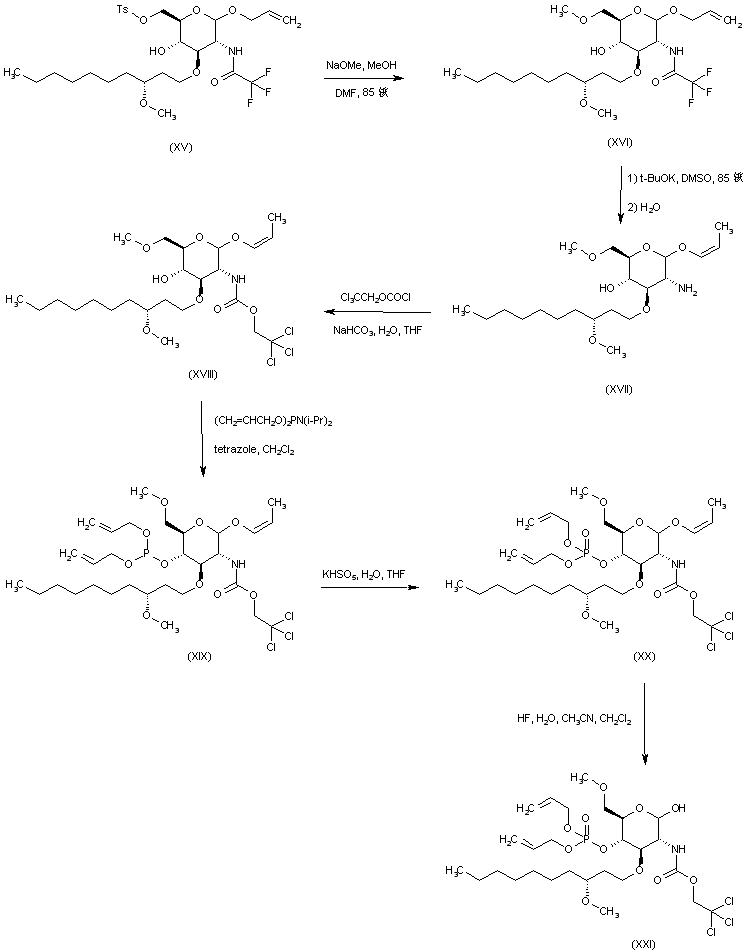 |
| 合成路线图解说明: Displacement of the tosylate group of (XV) by sodium methoxide produced the methyl ether (XVI). Hydrolysis of the trifluoroacetamide function of (XVI) using potassium tert-butoxide in hot DMSO took place with simultaneous allylic double bond isomerization, leading to enol ether (XVII). After protection of the amino group of (XVII) as the trichloroethyl carbamate (XVIII), phosphitylation of the secondary hydroxyl group of (XVIII) with diallyl N,N-diisopropylphosphoramidite in the presence of tetrazole-generated phosphite (XIX), which was further oxidized to phosphate (XX) employing Oxone (R). The O-propenyl group of (XX) was then hydrolyzed by means of HF to provide the monosaccharide building block (XXI). |
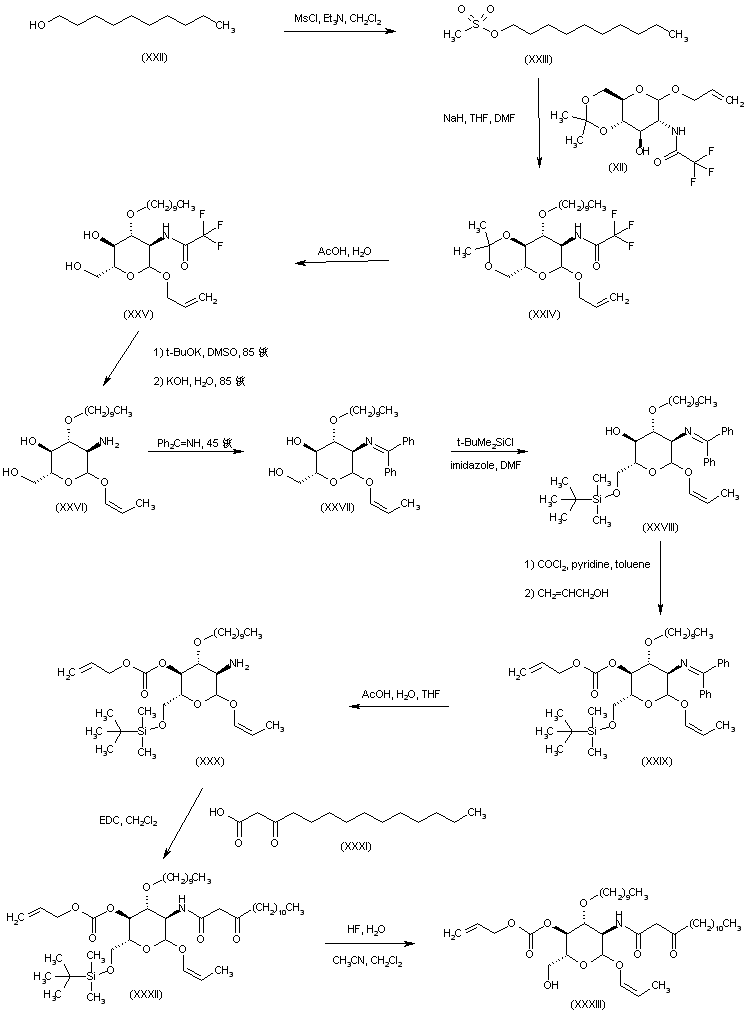 |
| 合成路线图解说明: The other monosaccharide building block (XXXIII) was also synthesized from the common intermediate (XII). Alkylation of (XII) with mesylate (XXIII), prepared from 1-decanol (XXII), gave the decyl ether (XXIV). After acidic acetonide hydrolysis of (XXIV) to yield (XXV), removal of the trifluoroacetamide by means of potassium tert-butoxide, with concomitant O-allyl group isomerization, furnished (XXVI). Imine (XXVII) was then obtained by exchange reaction of amine (XXVI) with benzophenone imine at 45 C. After silylation of the primary hydroxyl of (XXVII) with tert-butyldimethylsilyl chloride affording(XXVIII), the secondary hydroxyl group was protected as the allyl carbonate (XXIX) by sequential treatment with phosgene and then with allyl alcohol. Imine (XXIX) hydrolysis, followed by coupling of the resultant amine (XXX) with 3-oxotetradecanoic acid (XXXI) led to keto amide (XXXII). Precursor (XXXIII) was then obtained by desilylation of (XXXII) with HF. |
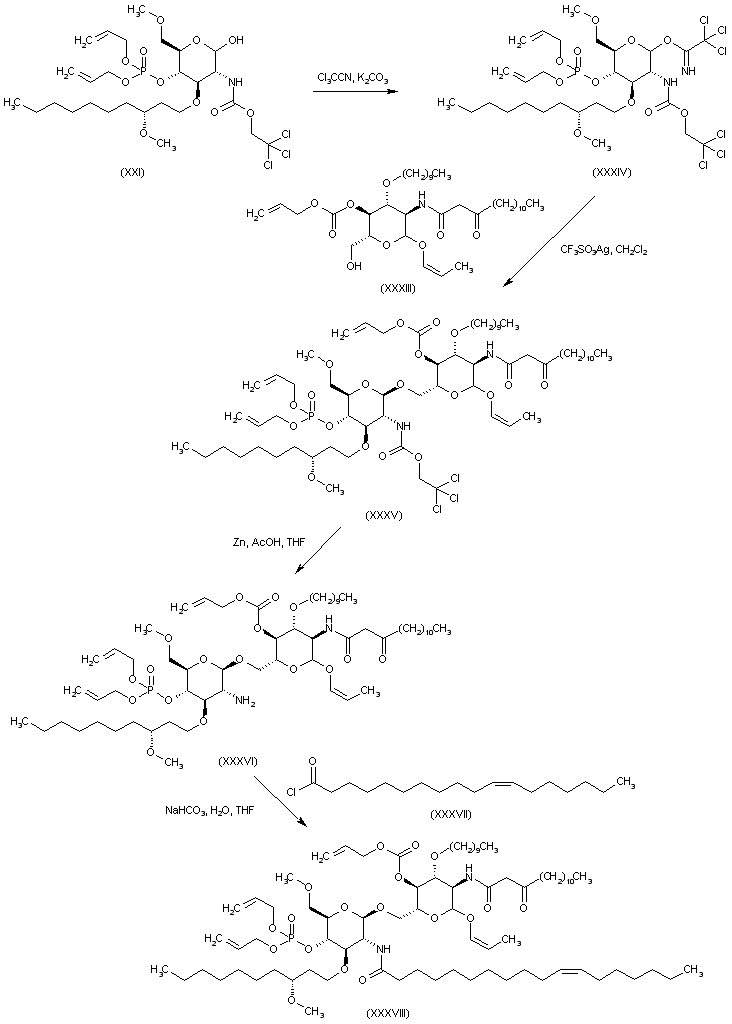 |
| 合成路线图解说明: Monosaccharide (XXI) was activated as the trichloroacetimidate (XXXIV) upon treatment with trichloracetonitrile. Coupling between the protected monosaccharide (XXXIII) and imidate (XXXIV) using silver triflate as the coupling promoter produced the protected disaccharide adduct (XXXV). After reductive cleavage of the trichloroethyl carbamate protecting group of (XXXV), the resultant amine (XXXVI) was acylated with vaccenoyl chloride (XXXVII) giving amide (XXXVIII). |
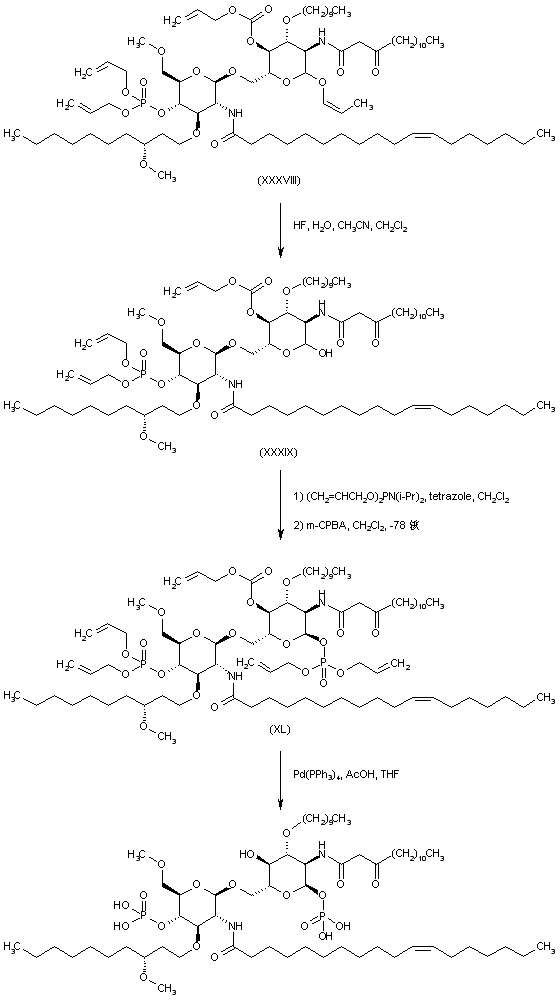 |
| 合成路线图解说明: Hydrolysis of the enol ether group of (XXXVIII) with HF yielded (XXXIX), which was converted to phosphate (XL) by sequential phosphitylation with diallyl N,N-diisopropylphosphoramidite, followed by oxidation with m-chloroperbenzoic acid. The title disaccharide was finally obtained by palladium-catalyzed deprotection of the allyl phosphate and carbonate ester groups of (XL). |
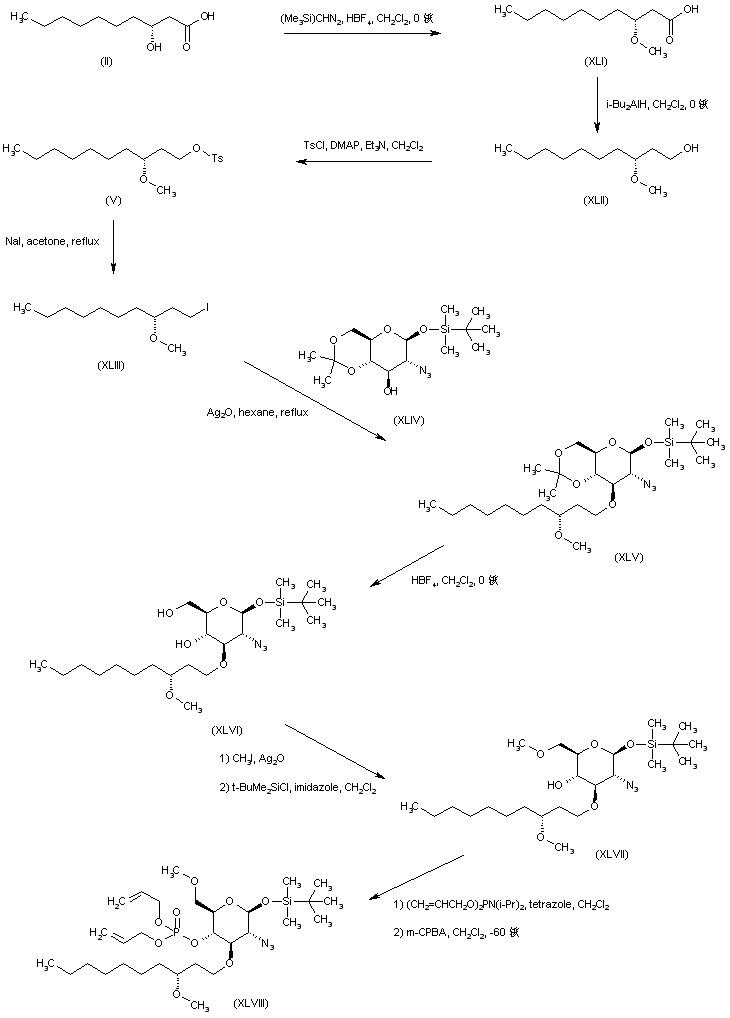 |
| 合成路线图解说明: Hydroxy acid (II) was converted to methyl ether (XLI) by treatment with trimethylsilyl diazomethane. Reduction of acid (XLI) to alcohol (XLII) was accomplished by treatment with DIBAL in cold dichloromethane. Alcohol (XLII) was transformed to alkyl iodide (XLIII) via tosylation to (V), followed by displacement of tosylate (V) with NaI in acetone. Alkylation of the known azido sugar (XLIV) with the alkyl iodide (XLIII) in the presence of Ag2O provided ether (XLV). Then, acidic acetonide (XLV) hydrolysis led to diol (XLVI). Selective alkylation of the primary hydroxyl group of (XLVI) using iodomethane in the presence of Ag2O, followed by reprotection of some desilylated product, furnished the methyl ether (XLVII). The secondary hydroxyl group of (XLVII) was then converted to phosphate ester (XLVIII) employing the same phosphitylation/oxidation sequence as above. |
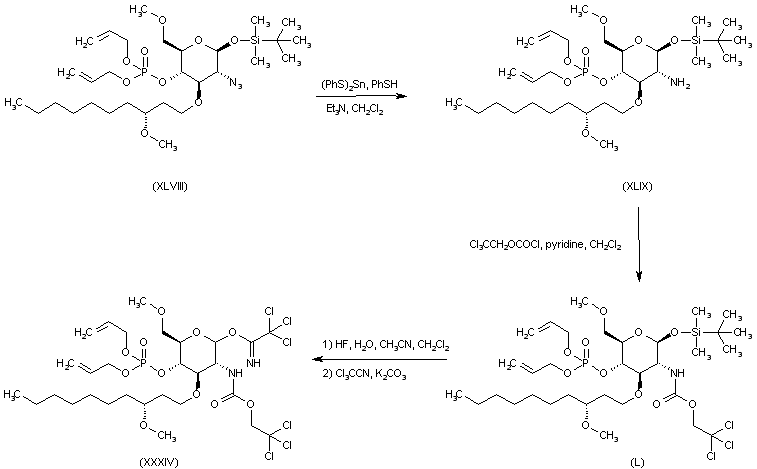 |
| 合成路线图解说明: Azido sugar (XLVIII) was reduced to the corresponding amine (XLIX) employing the in situ generated tin tris(benzenthiolate) triethylamine complex. Amine (XLIX) was then protected as the trichloethyl carbamate (L) by treatment with Troc-chloride and pyridine. After desilylation of (L) with HF, the resultant alcohol was activated as the trichloroacetimidate (XXXIV) as in Scheme 27814501e. |
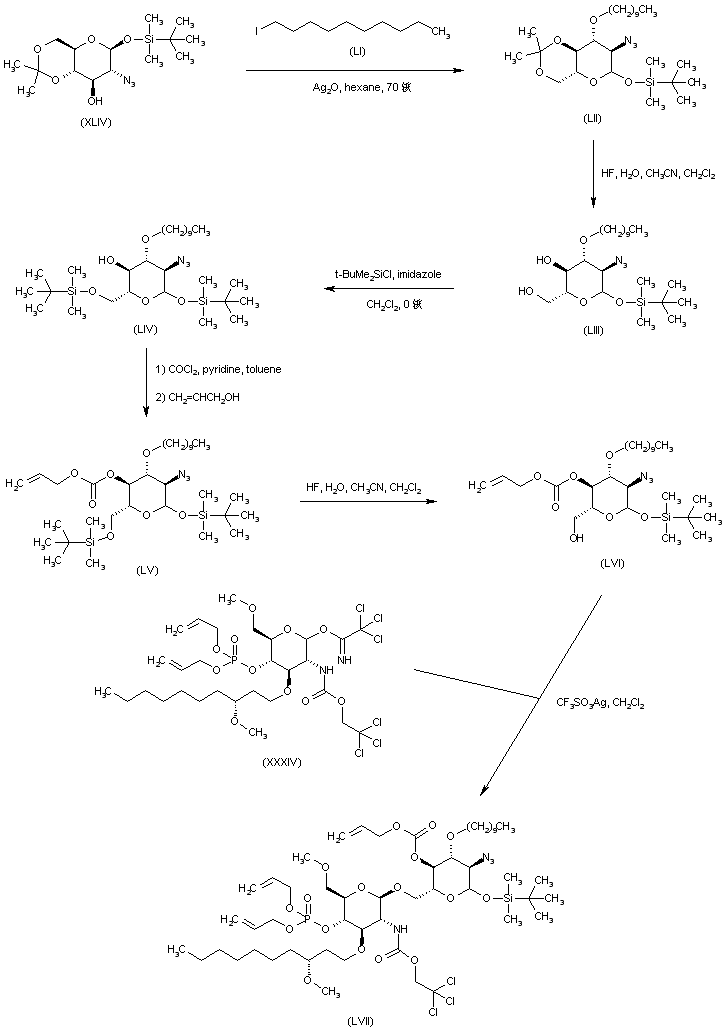 |
| 合成路线图解说明: Alkylation of azido sugar (XLIV) with 1-iododecane (LI) in the presence of Ag2O provided decyl ether (LII). Then, selective acetonide hydrolysis in (LII) to (LIII), followed by silylation with tert-butyldimethylsilyl chloride provided the bis-silyl ether (LIV). Alcohol (LIV) was then protected as the allyl carbonate (LV) by treatment with phosgene, followed by allyl alcohol. The primary silyl ether group of (LV) was selectively removed by treatment with HF giving the monosaccharide (LVI), which was coupled with imidate (XXXIV) yielding disaccharide (LVII). |
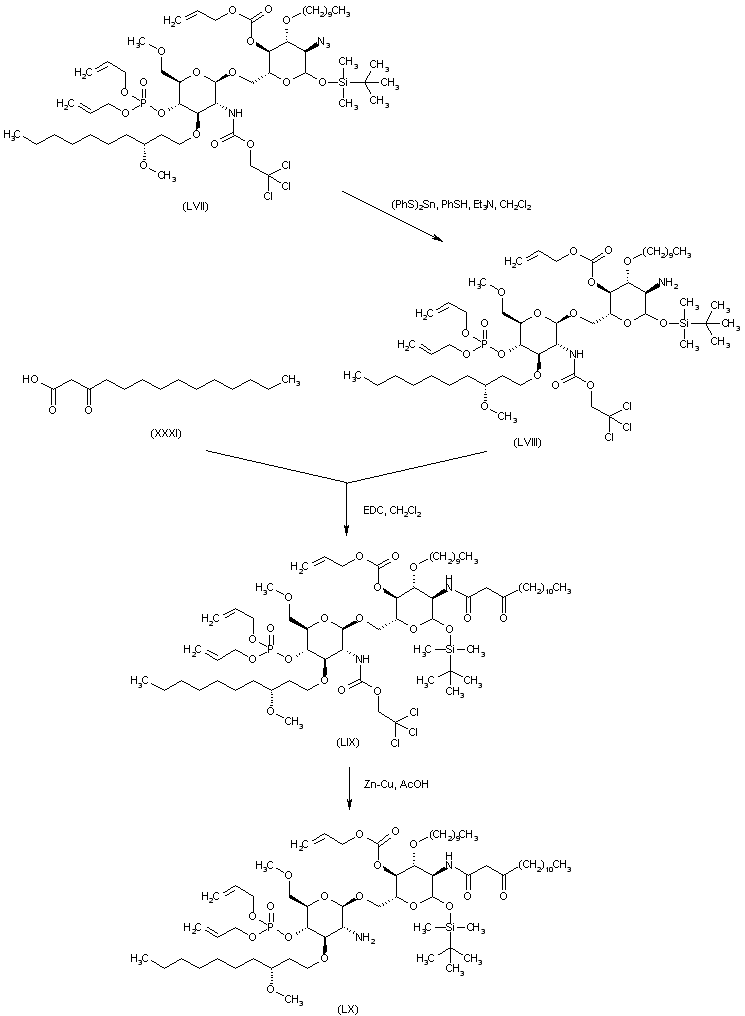 |
| 合成路线图解说明: Reduction of the azido group of disaccharide (LVII), followed by acylation of the resultant amine (LVIII) with keto acid (XXXI) produced keto amide (LIX). The Troc protecting group of (LIX) was then removed by reductive treatment with zinc-copper couple in AcOH yielding amine (LX). |
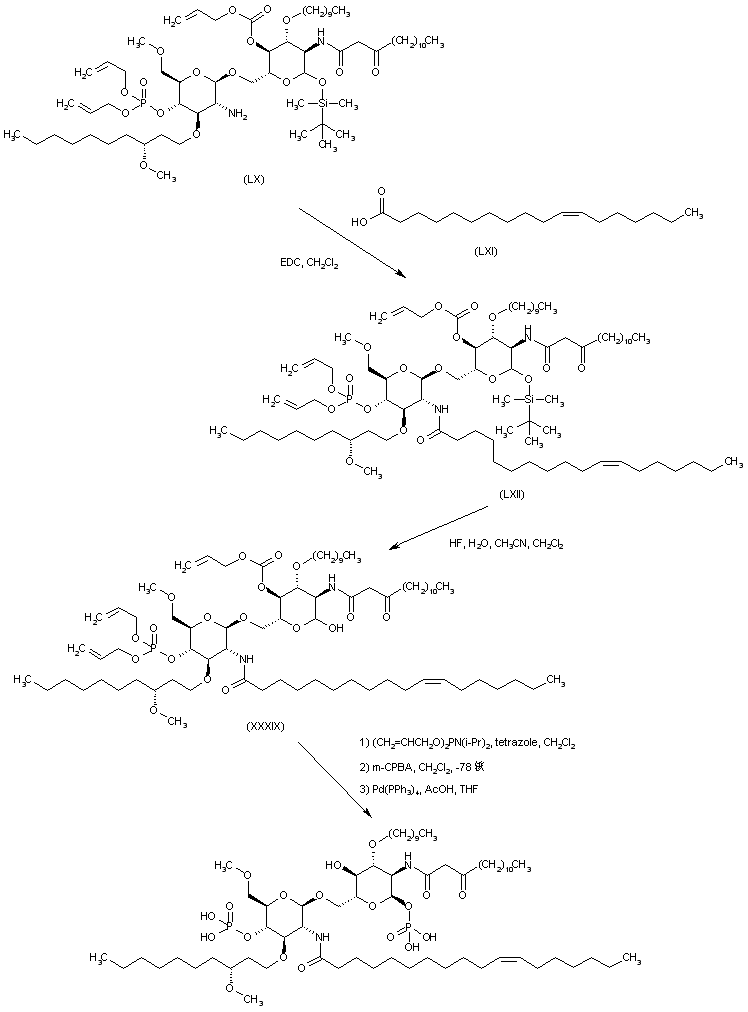 |
| 合成路线图解说明: Amine (LX) was acylated with cis-vaccenic acid (LXI) to produce amide (LXII). This was desilylated by means of HF yielding alcohol (XXXIX), which was finally converted to the title compound using the same sequence as in Scheme 27814501f. |